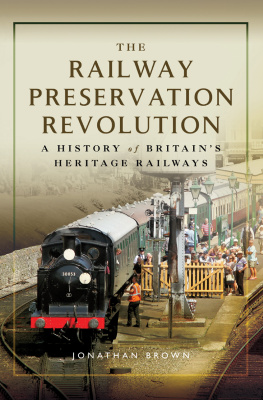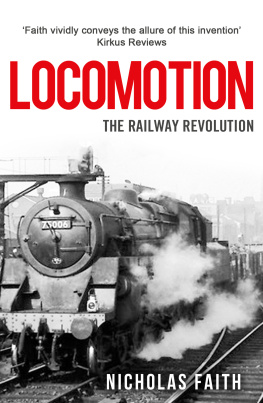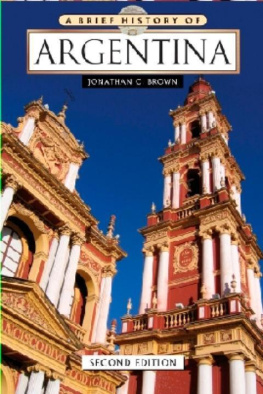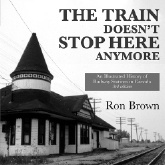Brown Jonathan - The Railway Preservation Revolution
Here you can read online Brown Jonathan - The Railway Preservation Revolution full text of the book (entire story) in english for free. Download pdf and epub, get meaning, cover and reviews about this ebook. year: 2017, publisher: Pen & Sword Books, genre: Politics. Description of the work, (preface) as well as reviews are available. Best literature library LitArk.com created for fans of good reading and offers a wide selection of genres:
Romance novel
Science fiction
Adventure
Detective
Science
History
Home and family
Prose
Art
Politics
Computer
Non-fiction
Religion
Business
Children
Humor
Choose a favorite category and find really read worthwhile books. Enjoy immersion in the world of imagination, feel the emotions of the characters or learn something new for yourself, make an fascinating discovery.
- Book:The Railway Preservation Revolution
- Author:
- Publisher:Pen & Sword Books
- Genre:
- Year:2017
- Rating:3 / 5
- Favourites:Add to favourites
- Your mark:
- 60
- 1
- 2
- 3
- 4
- 5
The Railway Preservation Revolution: summary, description and annotation
We offer to read an annotation, description, summary or preface (depends on what the author of the book "The Railway Preservation Revolution" wrote himself). If you haven't found the necessary information about the book — write in the comments, we will try to find it.
The Railway Preservation Revolution — read online for free the complete book (whole text) full work
Below is the text of the book, divided by pages. System saving the place of the last page read, allows you to conveniently read the book "The Railway Preservation Revolution" online for free, without having to search again every time where you left off. Put a bookmark, and you can go to the page where you finished reading at any time.
Font size:
Interval:
Bookmark:

THE
RAILWAY PRESERVATION REVOLUTION

A HISTORY of BRITAINS HERITAGE RAILWAYS
JONATHAN BROWN

First published in Great Britain in 2017 by
Pen & Sword Transport
An imprint of Pen & Sword Books Ltd
47 Church Street, Barnsley, South Yorkshire S70 2AS
Copyright Jonathan Brown 2017
The right of Jonathan Brown to be identified as the author of this work has been asserted by him in accordance with the Copyright, Designs and Patents Act 1988. All rights reserved. No part of this publication may be reproduced or transmitted in any form or by any means, electronic or mechanical, including photocopy, recording or any information storage and retrieval system, without the prior written permission of the publisher, nor by way of trade or otherwise shall it be lent, re-sold, hired out or otherwise circulated without the publishers prior consent in any form of binding or cover other than that in which it is published and without a similar condition including this condition being imposed on the subsequent purchaser.
ISBN 978 1 47389 117 3
eISBN 978 147389 119 7
Mobi ISBN 978 147389 118 0
Pen & Sword Books Ltd incorporates the imprints of Pen & Sword Archaeology, Atlas, Aviation, Battleground, Discovery, Family History, History, Maritime, Military, Naval, Politics, Railways, Select, Social History, Transport, True Crime, and Claymore Press, Frontline Books, Leo Cooper, Praetorian Press, Remember When, Seaforth Publishing and Wharncliffe.
For a complete list of Pen & Sword titles please contact
Pen & Sword Books Limited
47 Church Street, Barnsley, South Yorkshire S70 2AS England
E-mail:
Website: www.pen-and-sword.co.uk
Preservation projects and openings, 1960-1979
Some unsuccessful preservation projects, 1960-1979
Some preserved railways opened, 1979-2000
Extensions, 1979-2000
Heritage railway projects and openings, 2001 onwards
Extensions planned and completed since 2001
Talyllyn Railway traffic figures, 1960-1970
| AcoRP | The Association of Community Rail Partnerships |
| AIR | Association of Independent Railways |
| ARPS | The Association of Railway Preservation Societies |
| BR | British Railways/British Rail |
| CVR | Churnet Valley Railway |
| DVR | Dart Valley Railway |
| ELR | East Lancashire Railway |
| FR | Ffestiniog Railway |
| GCR | Great Central Railway |
| HLF | Heritage Lottery Fund |
| HRA | Heritage Railway Association |
| KESR | Kent and East Sussex Railway |
| KWVR | Keighley and Worth Valley Railway |
| LCGB | Locomotive Club of Great Britain |
| LMS | London Midland and Scottish Railway |
| LNER | London and North Eastern Railway |
| LNWR | London and North Western Railway |
| M&GN | Midland and Great Northern |
| NR | Network Rail |
| NVR | Nene Valley Railway |
| NYMR | North Yorkshire Moors Railway |
| ORR | Office of Rail Regulation/Office of Rail and Road |
| RHDR | Romney Hythe and Dymchurch Railway |
| SRA | Strategic Rail Authority |
| SRPS | Scottish Railway Preservation Society |
| TR | Talyllyn Railway |
| TRPS | Talyllyn Railway Preservation Society |
| UDC | Urban District Council |
| WHR | Welsh Highland Railway |
| WSR | West Somerset Railway |
I t was while riding on one of the preserved railways that the thought came: theres already a fifty-year history to these railways that deserves study. On sharing this thought with my wife, she said, That seems like a project for you. Fifty years since the foundation of the first preserved railway became sixty, sixty-five and more, so this book has had a gestation similar in length to most preservation schemes.
There are now several preserved or heritage railways that have been in operation for forty years or more a remarkable achievement in itself but for many the longest period of settled ownership in their history. Its longer than the time they were part of British Railways, and longer than the period of the grouped railways. In the 1950s these preserved railways were curiosities, but now they are part of the fabric of British social and economic life. They are part heritage attraction alongside the stately homes and ancient monuments, part leisure activity, good for a day out with Thomas the Tank Engine, part form of transport, and for some a thriving business, generating millions for the local economy.
These railways are about preserving our history. Yet, characteristically, their own history has had little attention. The exception is the Welsh narrow-gauge railways the pioneers on the Talyllyn and Ffestiniog, for example. The revival of the Welsh Highland Railway was such an epic struggle that already half a dozen books have been written about it. Elsewhere though, coverage is patchy, so I hope my attempt to draw together some of the broad themes of the railway preservation story will stimulate attention.
Theres plenty of scope. I havent covered anything like the range of social and economic aspects alluded to earlier. And this story is drawn almost entirely from the published record, mostly in magazines, with a small amount of oral history mixed into that. The magazines do not give all the story, however, and that includes the journals of the preservation societies.
This story is about the preserved railways as operational entities. It does not detail the locomotives, coaches and other artefacts preserved on the railways, although they enter the story at appropriate points. I also do not cover railway museums and centres, independent workshops and engineering establishments for the preserved railways. Even with such exclusions, theres still some blurring around the edges of defining what is a preserved (or heritage) railway. I have not worried about such things. There are probably slight discrepancies between figures for numbers of railways derived from different sources; otherwise the effect is limited.
My father introduced me to the concept of preserved railways many years ago. He was a great supporter of the Talyllyn Railway in many ways a few of his photographs are included here. As this project got going he did a lot of research, checking references. He died a few years ago, so unfortunately hasnt seen the end result. My brother is among several people who have read drafts of the text, including my wife Patricia and Peter Bosley; he provided photographs as well as helpful comment. I am grateful, too, to Mark Casson, who provided a forum at the Centre for Institutional Performance in the University of Reading, where I presented a paper trying out some of the arguments contained in this book; the comments by members of that conference were further help. John Scott-Morgan has been a stimulating and supportive editor. He came up with the title as well. Peter Waller of the Online Transport Archive was a great help in finding photographs. Finally my thanks go to all those staff and volunteers on the railways I have visited during the course of research and writing, for sharing their enjoyment of working on these lines. In many ways this is their book.
Next pageFont size:
Interval:
Bookmark:
Similar books «The Railway Preservation Revolution»
Look at similar books to The Railway Preservation Revolution. We have selected literature similar in name and meaning in the hope of providing readers with more options to find new, interesting, not yet read works.
Discussion, reviews of the book The Railway Preservation Revolution and just readers' own opinions. Leave your comments, write what you think about the work, its meaning or the main characters. Specify what exactly you liked and what you didn't like, and why you think so.











